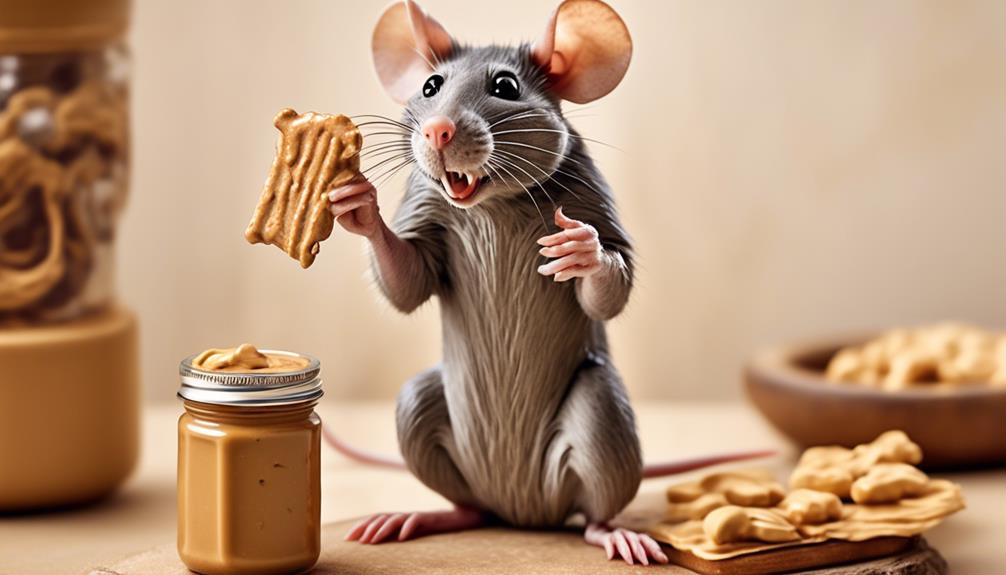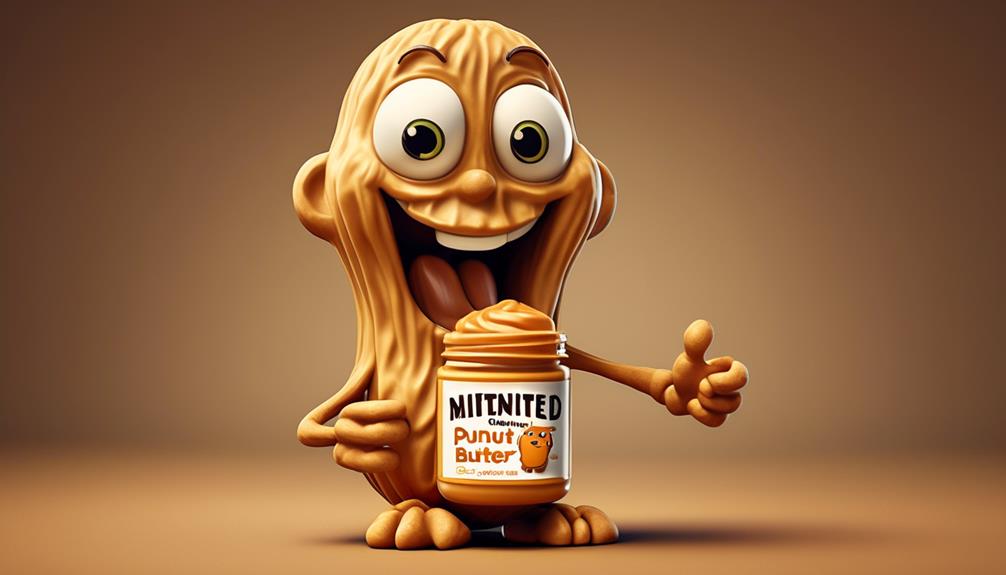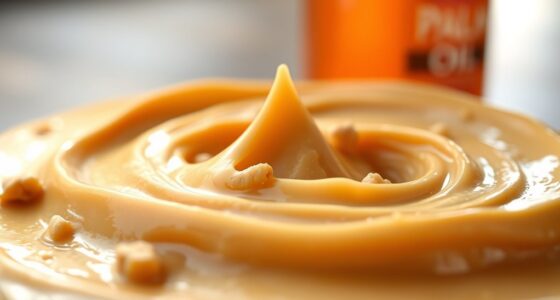Imagine this scenario: you’re enjoying a picnic when suddenly you spot a rat darting around, lured in by the tempting scent of peanut butter.
You might wonder what could happen if the little critter indulges in a taste of that creamy treat.
Well, let's just say it's not as straightforward as you might think. There are a few potential outcomes, some of which might surprise you.
But before we delve into the details, it's important to understand the potential impact of peanut butter on a rat's well-being.
Key Takeaways
- Peanut butter is a rich source of protein and fat for rats, which are essential for their balanced diet and overall health.
- The healthy fats in peanut butter promote skin and coat health in rats, while also providing an energy boost for them to stay active.
- Peanut butter contains vitamins and minerals beneficial for rats' health, and it can also be used to administer medications to them.
- However, feeding peanut butter to rats should be done in moderation and with caution, as it can pose risks such as choking hazards, toxic fungal toxins, high sugar and salt content, and the potential for severe liver damage due to aflatoxins. It is best to prioritize the well-being of rats and opt for healthier treats.
Nutritional Value of Peanut Butter for Rats
Peanut butter is a rich source of protein and fat, providing essential nutrients for a rat's diet. Rats, as omnivores, require a balanced diet that includes adequate protein and fat. Peanut butter, in moderation, can be a safe and nutritious addition to a pet rat's diet.
The high protein content in peanut butter is beneficial for the growth and repair of tissues in rats. Additionally, the healthy fats present in peanut butter can contribute to the overall skin and coat health of pet rats. Moreover, the caloric richness of peanut butter offers an energy boost to rats, enabling them to stay active and thrive.
When considering foods for pet rats, it's important to ensure that they're safe, and peanut butter, in controlled portions, can serve as a tasty and enjoyable treat for these intelligent creatures. However, it's crucial to offer peanut butter in moderation to prevent potential health issues associated with overconsumption, such as obesity and other health complications.
Potential Health Benefits for Rats

Transitioning from the nutritional value of peanut butter for rats, it's important to explore the potential health benefits that can be derived from incorporating this food into their diet.
Peanut butter can serve as a good source of protein for rats, providing essential nutrition for their overall health and well-being. Additionally, the high-fat content in peanut butter can offer a source of energy for rats, supporting their daily activities and metabolic needs.
Furthermore, peanut butter contains a variety of vitamins and minerals, such as vitamin E and niacin, which can contribute to the overall health of rats when included as part of a balanced diet. When given in moderation, peanut butter can also be used as a tool for administering medications to rats, making it easier to ensure they receive necessary treatments.
Additionally, the creamy texture of peanut butter may serve as a source of enrichment for rats, providing mental stimulation during consumption. However, it's crucial to emphasize that while peanut butter can offer health benefits, overfeeding can lead to potential health problems for rats, so it should be given in limited quantities.
Risks and Dangers of Feeding Peanut Butter to Rats

Feeding peanut butter to rats carries significant risks and dangers that warrant careful consideration when choosing their dietary options. When it comes to peanut butter and rats, there are several risks to be aware of:
- Choking Hazard: The sticky texture of peanut butter can pose a choking risk for rats, especially when consumed in large amounts or by younger or older rats with smaller airways.
- Toxic Fungal Toxins: Commercially available peanut butter may contain fungal toxins such as aflatoxins, which can be harmful to rats. Aflatoxins are known to cause liver failure and neurotoxic effects in rats.
- High Sugar and Salt Content: The high sugar and salt content in peanut butter can be deleterious to a rat's health, potentially leading to obesity, diabetes, and other health issues.
- Liver Health: Aflatoxins, commonly found in peanut butter, are particularly concerning as they can lead to severe liver damage in rats.
Given these risks, it's best to avoid feeding peanut butter to rats and opt for healthier treats such as fruits and vegetables.
Recommended Quantity of Peanut Butter for Rats

When it comes to feeding peanut butter to rats, it's crucial to consider the recommended quantity. Offering very small amounts and spreading it thinly can help minimize the risk of choking.
While peanut butter should only be an occasional treat, it's essential to prioritize the safety and well-being of our furry friends.
Safe Peanut Butter Amount
In considering the appropriate quantity of peanut butter for rats, it's imperative to offer very small amounts due to the potential negative health effects associated with excessive consumption. When it comes to feeding peanut butter to rats, it's crucial to keep the portions minimal. Our approach should prioritize the well-being of these small creatures.
Here are some key considerations:
- Offer very small amounts to minimize choking risk.
- Spread peanut butter thinly or let rats lick tiny amounts off fingers to minimize choking risk.
- Choking risk can't be completely eliminated, so it's best to avoid feeding peanut butter to rats.
- Peanut butter should only be an occasional treat, if at all, and shouldn't be a substitute for a balanced diet for rats.
When it comes to the well-being of our furry friends, it's essential to prioritize their health and safety.
Potential Health Risks
Considering the potential health risks associated with excessive consumption of peanut butter for rats, it is essential to prioritize their well-being by offering very small amounts to minimize the risk of choking and exposure to harmful toxins. Commercial peanut butter may contain fungal toxins like aflatoxins, which can lead to liver failure and neurotoxic effects in rats. Moreover, the high sugar and salt content in commercially available peanut butter can be unhealthy for pet rats, even in small quantities. Aflatoxins in peanut butter have been linked to cancer development in rats, making it crucial to limit their exposure to this toxin. Due to these risks, peanut butter should only be an occasional treat, offered in very small amounts, if at all, to minimize potential health concerns for pet rats.
| Potential Health Risks of Peanut Butter for Rats | Effects on Rats |
|---|---|
| Choking Hazard | Risk of choking due to sticky consistency |
| Mycotoxins | Liver failure, neurotoxic effects, and cancer risk |
| High Sugar and Salt Content | Unhealthy, even in small quantities |
These risks stem from the high levels of sugar, salt, and aflatoxins in peanut butter, which can be toxic to rats, posing significant dangers to their well-being.
Nutritional Benefits
To provide rats with a nutritious and enjoyable treat, offering small amounts of peanut butter, spread thinly or presented for licking off fingers, can be a beneficial option. When considering the nutritional benefits of feeding rats peanut butter, it's important to keep in mind the recommended quantity and its role in their balanced diet.
Here are some key points to consider:
- Peanut butter is high in protein and fat, which can be good for rats when offered in small amounts.
- Very small amounts of peanut butter should be given to rats to minimize the risk of choking.
- It should only be an occasional treat, as excessive consumption can lead to negative health effects.
- Alternative treats like fruits can be healthier choices for rats, and almond butter can also be considered in moderation.
Rats love peanut butter, but it's essential to ensure that it's offered in a way that aligns with their nutritional needs and overall well-being.
Varieties of Peanut Butter Suitable for Rats

Creamy peanut butter, organic peanut butter, unsalted peanut butter, homemade peanut butter, and natural peanut butter are all suitable varieties for rats due to their smooth textures, minimal additives, and controlled ingredients. Rats can eat these varieties safely, as they're low in calories and don't contain added sugars, making them suitable for rats who are often fussy eaters and may love peanut butter.
When feeding your rats peanut butter, it's important to consider their dietary needs and preferences. Rats can eat peanut butter in moderation, and these varieties provide a good source of healthy fats for them. Additionally, the smooth texture of these peanut butter varieties makes them easier for rats to consume.
As rats are known to love peanut butter, providing them with suitable options can be a great way to offer them a treat without compromising their health. It's essential to avoid sweet foods, high salt content, and excessive additives, making these varieties the ideal choices for including peanut butter in your rats' diet.
Other Foods to Avoid Feeding Rats

When considering the diet of pet rats, it's important to be mindful of the potential health risks associated with certain foods.
Some foods that are commonly found in households may pose risks to a rat's well-being, including certain fruits, vegetables, and processed foods.
Understanding which foods to avoid can help ensure the health and longevity of pet rats.
Foods to Avoid
Feeding rats certain human foods can pose health risks, and it's important to be mindful of what to avoid offering them. When it comes to feeding your rat, it's best to avoid certain foods due to potential health risks. Rats will eat almost anything, but some foods can be harmful to them.
Here are some foods to avoid:
- High-fat Foods: Rats have a particular fondness for fatty foods, but these can lead to obesity and health issues.
- Sugary Treats: Foods containing high levels of sugar can contribute to diabetes and dental problems in rats.
- Processed Foods: Rats shouldn't consume heavily processed or artificially flavored foods due to potential health implications.
- Human Junk Food: It's best to avoid feeding rats human junk food, as it lacks the essential nutrients they need.
Always prioritize your rat's health by offering them a balanced and wholesome diet.
Potential Health Risks
We must continue our focus on the dietary considerations for rats by addressing additional foods that pose potential health risks. It's essential to also avoid feeding them high-fat and high-sugar foods, as these can lead to obesity and related health issues in rats. While peanut butter can lead to respiratory distress in rats, excessive protein content in their diet can also have adverse effects on their health. By being mindful of what we offer them, we can provide a balanced diet that meets their nutritional needs without leading to overconsumption of certain nutrients. This will ensure the well-being of our pet rats and minimize the likelihood of health complications.
Summary and Best Practices for Rat Nutrition

Discussing the optimal nutrition for pet rats involves evaluating the risks and benefits of various food options. When it comes to feeding your rats, it's important to consider their specific dietary needs. Here are some best practices for ensuring your pet rats have a healthy diet:
- Rats have particular dietary requirements: Understanding the specific nutritional needs of rats is crucial for their overall health and well-being.
- Feed your rats a balanced diet: It's essential to provide a well-balanced diet that includes a mix of high-quality rat pellets, fresh fruits, and vegetables.
- Fruits and vegetables are essential: Incorporating a variety of fruits and vegetables into your rats' diet can provide essential vitamins, minerals, and fiber necessary for their health.
- Be mindful of treats: While occasional treats can be a part of a rat's diet, it's important to choose treats that are safe and healthy for them. Avoid high-fat and high-sugar treats, and opt for healthier alternatives such as small amounts of nut butter or fresh fruits.
When considering the food for pet rats, it's crucial to prioritize their well-being by providing a balanced and nutritious diet that meets their specific nutritional requirements.
Frequently Asked Questions
What Food Is Bad for Rats?
Some foods are harmful to rats, like chocolate, alcohol, caffeine, onions, garlic, citrus, grapes, and raw eggs. These can be toxic and may cause health issues. It's crucial to avoid high-fat, sugary, and protein-rich foods, as well as excessive fresh fruits and vegetables.
Certain foods, such as avocado, onions, and citrus, contain toxic compounds for rats. Therefore, it's important to be mindful of what we feed them to ensure their well-being.
How Much Peanut Butter Can Rats Have?
We must be cautious with peanut butter and rats. Small amounts can be given, but it must be spread thinly to prevent choking. Even then, there's still a risk.
It's best to limit peanut butter as an occasional treat or consider almond butter as an alternative. Monitoring for any adverse reactions is crucial.
We want our furry friends to stay safe and healthy, so it's essential to be mindful of their dietary choices.
Can Rats Eat Reese's?
Sure, rats can eat Reese's in small quantities, but it's not recommended due to the high sugar and chocolate content. The high sugar can lead to obesity and dental issues, while chocolate contains theobromine, which is toxic to rats.
It's best to stick to safer treats like fruits or small amounts of almond butter. Always consult a veterinarian for specific dietary advice to ensure the health and well-being of your pets.
Is It Safe to Eat Food Eaten by Rats?
Yes, it's generally safe to eat food that has been eaten by rats, but caution is essential. Rats can carry diseases and parasites, so it's crucial to ensure the food isn't contaminated.
It's important to properly handle and store food to prevent rat contact. If in doubt, it's best to discard the food. Maintaining hygienic practices and securing food storage areas can help minimize the risk of contamination.
Conclusion
In conclusion, offering peanut butter to rats should be done sparingly and in moderation.
Like a delicate balance of flavors in a gourmet dish, peanut butter can be a delightful treat for rats when given in small amounts.
However, just as too much salt can ruin a meal, excessive peanut butter can pose health risks for rats.
By carefully monitoring their intake and choosing the right type of peanut butter, we can ensure the well-being of our rodent friends.









